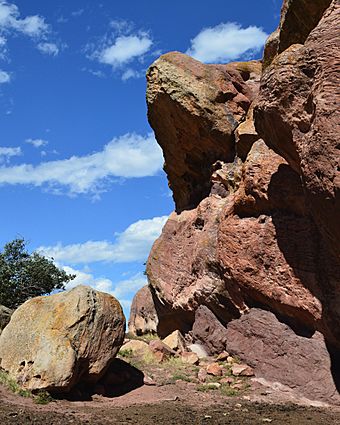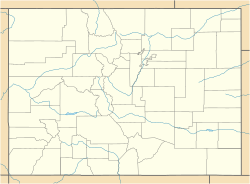LoDaisKa site facts for kids
Quick facts for kids |
|
|
LoDaisKa site
|
|
 |
|
| Location | Off U.S. Route 285 |
|---|---|
| Nearest city | Morrison, Colorado |
| Area | 3.4 acres (1.4 ha) |
| NRHP reference No. | 03000962 |
| Added to NRHP | September 25, 2003 |
The LoDaisKa site is an important archaeological site in Colorado, United States. It is located inside a rockshelter near the town of Morrison. People first lived in this rockshelter a very long time ago. They lived there from about 3000 BC to 1000 AD. This covers the Archaic and Middle Ceramic periods.
Contents
Where is the LoDaisKa Site Located?
The LoDaisKa site is found near Morrison, close to U.S. Route 285. It sits in the foothills of the southern Rocky Mountains. The site is about 6,200 feet (1,900 m) high. A steep ridge, called a hogback, was formed here from uplifted Dakota Sandstone.
The rockshelter is protected by a special 60-foot "red rock" formation. This formation was created when Fountain Formation rock was pushed upwards. The Morrison area is important because it's between two major groups of early people. These were the Desert societies from west of the Rockies and the Great Plains people to the east.
Who Lived at LoDaisKa?
In the Denver area, scientists divide ancient times into three main periods. These are the Paleo-Indian, Archaic, and Ceramic periods. At the LoDaisKa site, researchers Cynthia C. Irwin and Henry Irwin identified five different groups of people. They called these groups Complex A through E, with Complex E being the oldest.
The First People: Paleo-Indians
The time before the first humans came to Colorado was the Ice Age. This was about 16,000 years ago. Over thousands of years, the land changed a lot. Many large animals, like mastodons and mammoths, died out. As glaciers melted, they formed rivers and uncovered the Rocky Mountains.
Huge animals like camels, giant sloths, and ancient bison once roamed here. Early Paleo-Indian groups, like the Clovis people, used large tools to hunt these big animals. As the climate got warmer and drier, these giant animals disappeared. People then hunted smaller animals and gathered wild plants. This led to new cultures, like the Folsom tradition, who used smaller tools.
The very first artifacts found at the LoDaisKa rockshelter are from the Paleo-Indian period. These ancient remains belong to Complex E.
Hunters and Gatherers: Archaic Periods
People during the Archaic period (from about 5500 to 1 BC) hunted small animals. They hunted deer, antelope, and rabbits. They also gathered wild plants. These groups moved from place to place with the seasons, following food sources. Later in this period, around 200–500 AD, people started growing corn. They also began making pottery to store their food.
The LoDaisKa site is linked to the Mount Albion complex. This was an Early Archaic culture from the Plains, dating from about 4050 to 3050 BC. They were known for their unique Mount Albion corner-notched tools.
Early Farmers: Ceramic Periods
The Early Ceramic period, also known as the Woodland, began around 1 AD in the Plains. A key change was the creation of pottery wrapped with cords. People also started living in more settled areas. They began using smaller projectile points for bows and arrows.
Artifacts found at LoDaisKa show that people lived there into the Middle Ceramic period. Not many rockshelters in Colorado were used for such a long time.
What Did Archaeologists Find?
Archaeologists found many items at the LoDaisKa site. These include animal hides, plant remains, wooden tools, and many non-perishable items. These artifacts date from 3000 BC to 1000 AD. They are sorted into five main groups, or complexes, from A to E.
Artifacts from Different Time Periods
| Time Period | What We Found | Interesting Facts |
|---|---|---|
| Paleo-Indian (Complex E) | Parallel flaked points and stone chips. | These are the oldest items found. They were made from gravel near the rockshelter. |
| Middle Archaic (Complex D) | Triangular projectile points, knives, choppers, scrapers, drills, hammerstones. Also paint stones, beads, and gaming pieces. | These tools are similar to those found in the Great Basin Desert Culture. Evidence of early farming was also found. |
| Middle Archaic (Complex C) | Shouldered, concave base, stemmed dart points (like Duncan points). Cutting tools, scrapers, milling slabs, and hearths. | These tools are similar to those from the McKean complex in Wyoming. |
| Early and Middle Ceramic (Woodland) (Complex B) | A new type of corn (16-row popcorn-like maize) and Woodland-style pottery. | This type of corn has also been found at the Lawson site in Nebraska. Charcoal found here dates from 700 to 1000 AD. |
| Late Archaic / Early Ceramic (Complex A) | Pottery and corncobs. | The corn found here is similar to corn from the Bat Cave in New Mexico. This corn is called "Chapalote." The pottery is also a specific type called Turner Grey variety II. |
Researchers also found seven lumps of red and yellow ochre stones. These might have been the paint stones from Complex D. Stone boxes, called cists, were also found. These were used to store seeds, but we don't know exactly when or by which culture.
In 1961, scientists used radiocarbon dating to find out the age of the site. They learned that people first lived there around 3000 BC and stayed until at least 1000 AD. The tools found at LoDaisKa are similar to and from the same time as those found at other important sites. These include the McKean site in Wyoming and Signal Butte in Nebraska.
How the Site Was Studied
| Year | Who Studied It | What They Did |
|---|---|---|
| 1931–1932 | Dr. E. B. Renaud | He did the first archaeological survey of sites in the Morrison area. |
| Before 1958 | LoDaisKa Bethel | This was the first detailed survey of the LoDaisKa site. |
| 1958–1960 | Henry J. and Cynthia C. Irwin | They led the main excavations and studies of the site. |
Why LoDaisKa is Important
The discoveries made by the first archaeologists at LoDaisKa were very important. Other archaeologists often used what they learned from LoDaisKa to understand their own findings. Many other sites were dug up to answer questions that came from the research at LoDaisKa.
In 2003, the LoDaisKa site (also known as site ID 5JF142) was added to the National Register of Historic Places. It earned this honor because of the valuable archaeological evidence found there.
Images for kids




